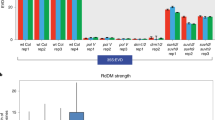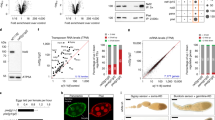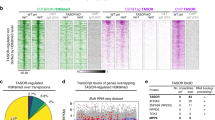Abstract
Retrotransposons and repetitive DNA elements in eukaryotes are silenced by small RNA–directed heterochromatin formation. In Arabidopsis, this process involves 24-nt siRNAs that bind to ARGONAUTE4 (AGO4) and facilitate the targeting of complementary loci1,2 via unknown mechanisms. Nuclear RNA polymerase V (Pol V) is an RNA silencing enzyme recently shown to generate noncoding transcripts at loci silenced by 24-nt siRNAs3. We show that AGO4 physically interacts with these Pol V transcripts and is thereby recruited to the corresponding chromatin. We further show that DEFECTIVE IN MERISTEM SILENCING3 (DMS3), a structural maintenance of chromosomes (SMC) hinge-domain protein4, functions in the assembly of Pol V transcription initiation or elongation complexes. Collectively, our data suggest that AGO4 is guided to target loci through base-pairing of associated siRNAs with nascent Pol V transcripts.
This is a preview of subscription content, access via your institution
Access options
Subscribe to this journal
Receive 12 print issues and online access
$209.00 per year
only $17.42 per issue
Buy this article
- Purchase on Springer Link
- Instant access to full article PDF
Prices may be subject to local taxes which are calculated during checkout






Similar content being viewed by others
References
Chapman, E.J. & Carrington, J.C. Specialization and evolution of endogenous small RNA pathways. Nat. Rev. Genet. 8, 884–896 (2007).
Girard, A. & Hannon, G.J. Conserved themes in small-RNA-mediated transposon control. Trends Cell Biol. 18, 136–148 (2008).
Wierzbicki, A.T., Haag, J.R. & Pikaard, C.S. Noncoding transcription by RNA Polymerase Pol IVb/ Pol V mediates transcriptional silencing of overlapping and adjacent genes. Cell 135, 635–648 (2008).
Kanno, T. et al. A structural-maintenance-of-chromosomes hinge domain-containing protein is required for RNA-directed DNA methylation. Nat. Genet. 40, 670–675 (2008).
Vaucheret, H. Plant ARGONAUTES. Trends Plant Sci. 13, 350–358 (2008).
Kanno, T. et al. A SNF2-like protein facilitates dynamic control of DNA methylation. EMBO Rep. 6, 649–655 (2005).
Li, C.F. et al. An ARGONAUTE4-containing nuclear processing center colocalized with Cajal bodies in Arabidopsis thaliana. Cell 126, 93–106 (2006).
Pontes, O. et al. The Arabidopsis chromatin-modifying nuclear siRNA pathway involves a nucleolar RNA processing center. Cell 126, 79–92 (2006).
Pontier, D. et al. Reinforcement of silencing at transposons and highly repeated sequences requires the concerted action of two distinct RNA polymerases IV in Arabidopsis. Genes Dev. 19, 2030–2040 (2005).
Kanno, T. et al. Atypical RNA polymerase subunits required for RNA-directed DNA methylation. Nat. Genet. 37, 761–765 (2005).
Xie, Z. et al. Genetic and functional diversification of small RNA pathways in plants. PLoS Biol. 2, e104 (2004).
Kasschau, K.D. et al. Genome-wide profiling and analysis of Arabidopsis siRNAs. PLoS Biol. 5, e57 (2007).
Cao, X. et al. Role of the DRM and CMT3 methyltransferases in RNA-directed DNA methylation. Curr. Biol. 13, 2212–2217 (2003).
Lister, R. et al. Highly integrated single-base resolution maps of the epigenome in Arabidopsis. Cell 133, 523–536 (2008).
Haag, J.R., Pontes, O. & Pikaard, C.S. Metal A and metal B sites of nuclear RNA polymerases Pol IV and Pol V are required for siRNA-dependent DNA methylation and gene silencing. PLoS ONE 4, e4110 (2009).
Peric-Hupkes, D. & van Steensel, B. Linking cohesin to gene regulation. Cell 132, 925–928 (2008).
El-Shami, M. et al. Reiterated WG/GW motifs form functionally and evolutionarily conserved ARGONAUTE-binding platforms in RNAi-related components. Genes Dev. 21, 2539–2544 (2007).
Bühler, M., Verdel, A. & Moazed, D. Tethering RITS to a nascent transcript initiates RNAi- and heterochromatin-dependent gene silencing. Cell 125, 873–886 (2006).
Bühler, M. & Moazed, D. Transcription and RNAi in heterochromatic gene silencing. Nat. Struct. Mol. Biol. 14, 1041–1048 (2007).
Onodera, Y. et al. Plant nuclear RNA polymerase IV mediates siRNA and DNA methylation-dependent heterochromatin formation. Cell 120, 613–622 (2005).
Peters, A.H.F.M. et al. Partitioning and plasticity of repressive histone methylation states in mammalian chromatin. Mol. Cell 12, 1577–1589 (2003).
Acknowledgements
Our work is supported by US National Institutes of Health grant GM077590. The content of the paper is the sole responsibility of the authors and does not necessarily reflect the views of the NIH. We thank T. Blevins (Washington University, St. Louis), S. Jacobsen (University of California, Los Angeles) and T. Jenuwein (Max Planck Institute of Immunobiology) for providing reagents.
Author information
Authors and Affiliations
Contributions
T.S.R. generated anti-AGO4; J.R.H. and T.S.R. assayed NRPE1–AGO4 interactions; J.R.H. produced Figure 4d; A.T.W. performed all remaining experiments. A.T.W. and C.S.P. wrote the manuscript.
Corresponding author
Rights and permissions
About this article
Cite this article
Wierzbicki, A., Ream, T., Haag, J. et al. RNA polymerase V transcription guides ARGONAUTE4 to chromatin. Nat Genet 41, 630–634 (2009). https://doi.org/10.1038/ng.365
Received:
Accepted:
Published:
Issue Date:
DOI: https://doi.org/10.1038/ng.365
This article is cited by
-
Barley AGO4 proteins show overlapping functionality with distinct small RNA-binding properties in heterologous complementation
Plant Cell Reports (2024)
-
A cryo-EM structure of KTF1-bound polymerase V transcription elongation complex
Nature Communications (2023)
-
The MOM1 complex recruits the RdDM machinery via MORC6 to establish de novo DNA methylation
Nature Communications (2023)
-
Conserved and non-conserved RNA–target modules in plants: lessons for a better understanding of Marchantia development
Plant Molecular Biology (2023)
-
Harnessing epigenetic variability for crop improvement: current status and future prospects
Genes & Genomics (2022)



